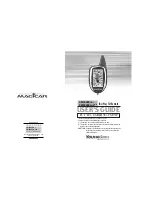
LISA-U2 series - System Integration Manual
UBX-13001118 - R19
Early Production Information
Design-In
Page 113 of 175
2
Design-In
2.1
Design-in checklist
This section provides a design-in checklist.
2.1.1
Schematic checklist
The following are the most important points for a simple schematic check:
DC supply must provide a nominal voltage at
VCC
pin above the minimum operating range limit.
DC supply must be capable of providing 2.5 A current pulses, providing a voltage at
VCC
pin above the
minimum operating range limit and with a maximum 400 mV voltage drop from the nominal value.
VCC
supply should be clean, with very low ripple/noise: provide the suggested series ferrite bead and
bypass capacitors, in particular if the application device integrates an internal antenna.
VCC
voltage must ramp from 2.5 V to 3.2 V within 1 ms to allow a proper switch-on of the module.
Do not leave
PWR_ON
floating: add a pull-up resistor to
V_BCKP
.
Do not apply loads which might exceed the limit for maximum available current from
V_INT
supply.
Check that voltage level of any connected pin does not exceed the specific operating range.
Capacitance and series resistance must be limited on each SIM signal to match the SIM specifications.
Insert the suggested low capacitance ESD protection and passive filtering parts on each SIM signal.
Check UART signals direction, since the signal names follow the
ITU-T V.24 Recommendation
Provide appropriate access to USB interface and/or to UART
RxD
,
TxD
lines and access to
PWR_ON
and/or
RESET_N
lines to flash/upgrade the module firmware using the u-blox EasyFlash tool.
Provide appropriate access to USB interface and/or to UART
RxD
,
TxD
,
CTS
,
RTS
lines for debugging.
Capacitance and series resistance must be limited on each line of the SPI / IPC interface.
Add a proper pull-up resistor to a proper supply on each DDC (I
2
C) interface line, if the interface is used.
Capacitance and series resistance must be limited on each line of the DDC interface.
Use transistors with at least an integrated resistor in the base pin or otherwise put a 10 k
Ω
resistor on
the board in series to the GPIO when those are used to drive LEDs.
Connect the pin number 5 (
RSVD
) to ground.
Check the digital audio interface specifications to connect a proper device.
Capacitance and series resistance must be limited on
CODEC_CLK
line and each I
2
S interface line.
Provide proper precautions for ESD immunity as required on the application board.
Any external signal connected to the UART interface, SPI/IPC interface, I
2
S interfaces and GPIOs must be
tri-stated when the module is in power-down mode, when the external reset is forced low and during
the module power-on sequence (at least for 3 s after the start-up event), to avoid latch-up of circuits
and let a proper boot of the module.
All unused pins can be left floating on the application board except the
PWR_ON
pin (must be
connected to
V_BCKP
by a pull-up resistor) and the
RSVD
pin number 5 (must be connected to GND).
















































